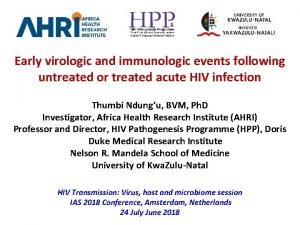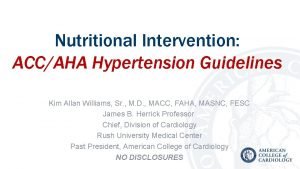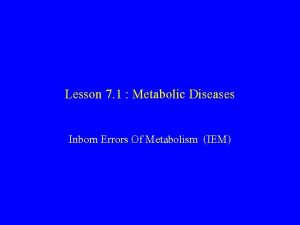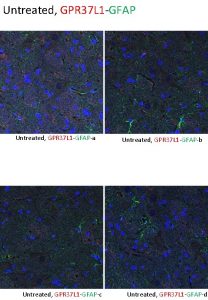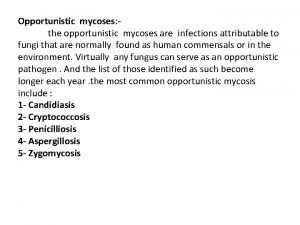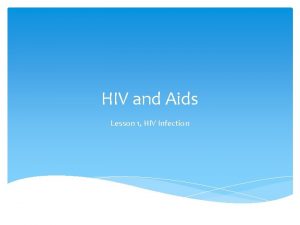OPPORTUNISTIC INFECTIONS In patients with untreated HIV infection








- Slides: 8

OPPORTUNISTIC INFECTIONS In patients with untreated HIV infection, decreasing • CD 4 cell counts predispose them to infections that do not usually occur in persons with an intact immune • system. These opportunistic infections usually develop when the CD 4 cell count is less than 200/μL and • become even more likely when the count is lower. However, mucocutaneous. Candida infection can develop with • CD 4 cell counts greater than 200/μL. Oral candidiasis (thrush) most often can be treated with topical agents • such as clotrimazole troches. Dysphagia or other swallowing symptoms indicate esophageal • involvement, and treatment of esophageal candidiasis requires a systemic agent such as fluconazole. •

Cryptoccocal meningitis Cryptococcus may be isolated to the lung • but usually has disseminated before diagnosis and manifests as subacute or chronic meningitis, cryptoccocal meningitis is usually diagnosed by CSF culture or by cryptoccocal antigen test in serum or CSF fluid. Treatment includes antifungal agents and • control of increased ICP by serial LP and shunting.

Pneumocystis jirovicii pneumonia Pneumocystis jirovecii pneumonia is a common • complication in patients with HIV infection who have not received prophylaxis. Patients present with subacute onset • of fever, dyspnea, and dry cough, and chest radiographs most commonly show diffuse interstitial or • alveolar infiltrates. Although the microorganisms may be found in induced sputum, • diagnosis usually requires stains of bronchoalveolar lavage fluid. High-dose trimethoprim-sulfamethoxazole is • the treatment of choice. During treatment, an immune response to dying microorganisms may actually • worsen disease in the first few days. Adjunctive glucocorticoids are beneficial and should be used in • patients with an arterial partial pressure of oxygen (breathing ambient air) of less than 70 mm Hg (9. 31 k. Pa) • or an alveolar-arterial gradient of greater than 35 mm Hg (4. 66 k. Pa). •

Toxoplasma gondii can cause encephalitis in patients • with CD 4 cell counts less than 100/μL. Diagnosis is typically based on signs and symptoms and imaging • findings. Patients present with headache, fever, focal neurologic deficits, and possibly seizures. Multiple • ring-enhancing lesions are seen on imaging studies. MRI is preferred to CT because of higher • sensitivity. Toxoplasmosis in patients with AIDS is almost always a reactivation disease; • therefore, results of serologic testing for anti. Toxoplasma Ig. G antibodies are usually positive. After presumptive • treatment (with pyrimethamine plus either sulfadiazine or clindamycin), patients should be assessed for • response within 1 or 2 weeks of starting therapy.

Mycobacterial infections Tuberculosis and MAC infection are the most common • mycobacterial infections in patients with AIDS. Tuberculosis may present at any CD 4 cell count, is more • likely to be extra pulmonary at presentation, and may not have the classic chest radiographic findings. • Treatment of tuberculosis and HIV confection must take into account drug interactions between the rifamycins • and many antiretroviral agents. MAC infection in patients with AIDS is usually disseminated at presentation • and develops at CD 4 cell counts less than 50/μL. Clinical features include fever, sweats, weight loss, • lymphadenopathy, hepatosplenomegaly, and cytopenias. Treatment involves a multidrug regimen with • clarithromycin or azithromycin as the cornerstone of therapy. •

CMV infections: Cytomegalovirus (CMV) infection in patients with • AIDS usually presents with specific end-organ dysfunction rather than a nonspecific systemic illness. The • most common manifestations are retinitis, esophagitis or colitis, and polyradiculitis or encephalitis. The • diagnosis may be made clinically or by demonstrating CMV by histopathology studies or NAAT. Initial • treatment of CMV infection is oral valganciclovir or intravenous ganciclovir. •

Skin opportunistic infections: Molluscum contagiosum is a poxvirus infection that • most commonly causes multiple small papules on the face and trunk; it usually responds to immune • reconstitution after treatment of the HIV infection. Bartonella infection causes bacillary • angiomatosis and is characterized by skin lesions that resemble Kaposi sarcoma (KS). KS is caused by a • herpes family virus (human herpes virus 8) and presents with lesions that may vary in color from red to purple to • brown and may be macules, papules, plaques, or nodules. KS is most often found on the skin but may • also occur on mucous membranes of the respiratory and gastrointestinal tracts. •

Management guidelines: 1 -the treatment by HAART(highly active antiretroviral • therapy). 2 -the treatment should be initiated in any adult with • symptoms ascribed to HIV infection regardless of CD 4 count. 3 -the treatment should be initiated in any • asymptomatic patients with CD 4 cell count less than 350 cells per microliter. 4 -treatment is recommended for 3 conditions • regardless of CD 4 count or whether the patient symptomatic or not. (pregnancy, HIV nephropathy, hepatitis B virus confection). 5 -Antiretroviral treatment should be offered to all • patients who are ready to take treatment.




